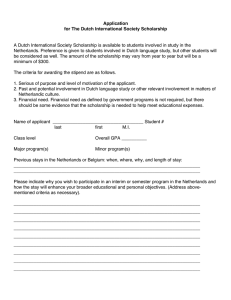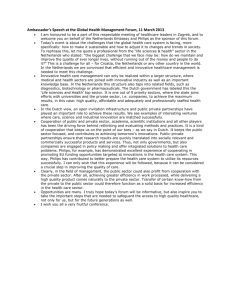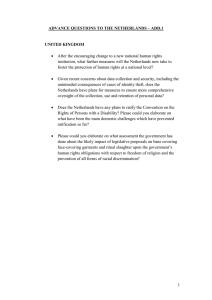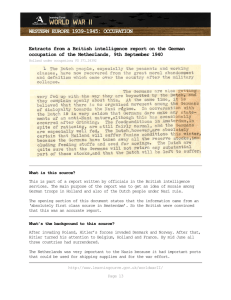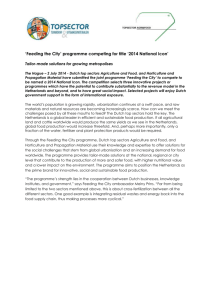The Netherlands A Country Profile Michael J. van Lierop
advertisement
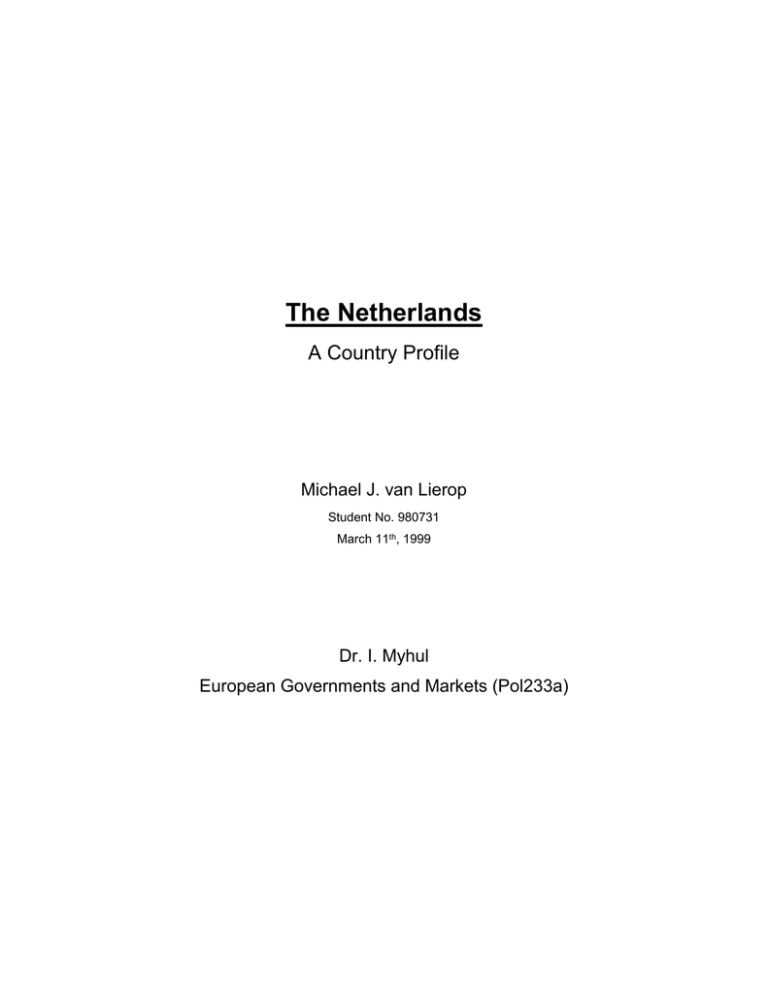
The Netherlands A Country Profile Michael J. van Lierop Student No. 980731 March 11th, 1999 Dr. I. Myhul European Governments and Markets (Pol233a) Michael J. van Lierop The Netherlands: A Country Profile The Netherlands: A Country Profile POLITICAL PROFILE Political Institutions. The make-up of the Netherlands, as with all nations, is characterized by its institutional dynamic. Comprising a multi-faceted government structure, the Netherlands is bound legally by the Dutch Constitution known as the grondwet, or Basic Law. While there is a body of accepted uncodified legal rulings that play an integral role in the proper functioning of the Dutch political system, it is the Basic Law of 1814-15 that delineates the state structures, roles and limitations.1 The Netherlands is headed by a ruling monarch and is governed by the Prime Minister and the elected legislative parliaments. The parliament, known as the Staten Generaal, is comprised of two elected chambers. The lower-house, or Second Chamber, is the principle legislative authority consisting of 150 members elected through a proportional representation national party-list system. The upper-house holds 75 members elected by the members of the 12 provincial state councils. No executive positions within the government are elected as such.2 Although the judiciary does not have any true policy-making role in the Netherlands, it does influence legislation through legal interpretation. The Council of State instead plays the role of constitutional court, and must ultimately be consulted in regards to government bills and proposals. While the rulings of the constitutional court are not formally binding, they carry considerable weight in affecting parliamentary decisions.3 Political Parties. There are five key political parties in the Netherlands. The Labour Party (PvdA) can be classified as a social democratic party, with only moderate and typically traditional leanings in social and economic domains. Popular support for this party has waned since the 1970s due to the “erosion of its traditional working-class Refer to “Constitution and Institutions” in Country Profile: Netherlands. The Economist, 1998. p.6. 2 Ibid. 3 Ibid, p.7. 1 1 Michael J. van Lierop The Netherlands: A Country Profile constituencies… [and] the maintenance of tight fiscal policies”.4 Nevertheless, under the leadership of Wim Kok, it has shifted to the centre ground of Dutch politics and has gained considerable support since. The People’s Party for Freedom and Democracy (VVD) – the Liberals - stands more to the centre-right than the Labour Party and is also gaining in popular support. Representing predominantly “conservative libertarians of the upper middle and professional classes”, it historically positions itself towards issues with a more hard-line stance, and remains the only mainstream Dutch party to have “expressed critical views on European political integration”.5 It is a close popular rival to the Labour Party, and could easily be labelled Labour’s fiercest opponent. The Democrats 66 (D66) is a party encompassing a variety of policies and positions spanning the entire Dutch political spectrum. As a result of poor grass-roots support, its popular appeal has risen and fallen, sometimes drastically, throughout the last few decades. With a highly eclectic policy and a fragile electoral base, it remains a coalition party – serving to bolster other parties and their influence, rarely its own. The Christian Democratic Appeal (CDA) was formed as an alliance of Catholic and Protestant mainstream parties and, up to the May 1994 election, was the dominant political force in the Netherlands. Despite its losses in 1994, primarily due to misguided policy plans for old-age pensions, it has and will continue to hold its political ground in the Netherlands with its “centrist, moderately conservative policies and conciliatory tradition”.6 The Green Left was formed from the remains of three left-wing parties – the Communist Party (CPN), the Pacifist Party (PSP) and the Radicals (PPR). Although its achievements as a new-comer in politics have been negligible, it wields considerable power in parliament and, due to the underperformance of the CDA, has in large part become the de facto oppositional force.7 4 Ibid, p.8. Ibid, p.9. 6 Ibid, p.9. 7 Ibid, p.10. 5 2 Michael J. van Lierop Elections. The Netherlands: A Country Profile The Dutch electoral system is based on universal suffrage for all persons over 18 years of age. A national party-list is compiled before each election, and members are directly elected by the population to the Second Chamber (or LowerHouse). The Prime Minister is not elected, but appointed as party leader and the government is established legally under the authority of the Queen. Due to the political system of proportional representation, “there are no minimum electoral thresholds that a political party must cross to achieve representation”.8 Current Government. As of May 1998, the current government of the Netherlands was lead by Prime Minister Wim Kok of the Labour Party, comprising ministers from the Labour, Liberal and Democratic parties. The coalition government won the general election and currently “commands a substantial majority, with 97 of the 150 seats”.9 POLITICAL PROBLEMS A number of political issues have arisen during the course of the 1990s in the Netherlands. Government policy has had to focus on these problems, some major endemic issues, others minor squabbles. Since 1994, legislation and government initiatives have been aimed at the “rationalisation of public finances and employment creation…”, and so have had to deal with the problems of “funding unexpectedly high social security payments” and the problems associated recently with dampening the aftershocks of the Asian, Russian and Latin American economic crises. NATO enlargement and European integration remain two highly controversial issues facing Dutch legislators and politicians as the populace appears heavily divided on such issues.10 ECONOMIC PROFILE Industrial. The manufacturing, distribution and industrial aspect of the Dutch economy depends heavily on imported materials. Still, it is an active part representing 18.1% of the working population and accounting for18.8% of GDP in 1996. Industry is 8 Ibid, p.6. “The Government Policy Statement” available at the Netherlands Ministry of Foreign Affairs on the web – http://www.bz.minbuza.nl/English/DEPTH/c_policyKok2.html 10 Refer to “Country Profile”, p.5. 9 3 Michael J. van Lierop The Netherlands: A Country Profile very internationally-oriented, and is dominated by the renowned multinationals such as Royal Dutch/Shell (oil), Unilever (food) Philips (electronics) and Heineken (brewing).11 Agriculture. This part of the economy is comparatively larger than in most other OECD countries, accounting for 3.2% of GDP in 1996 and 3.8% of the workforce. The Netherlands holds a position of pre-eminence on the world market for its horticultural products, flowers and bulbs, meats and dairy products.12 Service. The services sector of the Dutch economy represents an exceptionally large part of the country’s GDP and workforce. With an emphasis on real estate, transport and rental, as well as the financial services industry, the Dutch service sector accounts for 66% of GDP and 62.5% of the workforce.13 ECONOMIC SITUATION Growth/Stagnation in GNP/GDP. In 1998, Dutch economic growth peaked at 3.7% of the Gross Domestic Product. The Netherlands has maintained a level above 3% now for 10 successive quarters.14 Projected growth of the Dutch domestic economy has been set by the government at an average of 2.25% for the years spanning 1999-2002.15 Inflation. Inflation rates in the Netherlands have been relatively high for the last several years, averaging 2.1% in 1996, 2.2% in 1997, though is estimated to be less than 1.75% in 1999. Average inflation in the EU was 1.3% in 1998. 16 Budget. The government budget has been and continues to be in the red this year, though the deficit remains safely below the 3% of GDP ceiling set by the EU for monetary union. Government expenditures are consistently aimed at social welfare policy programs, but as economic growth remains high, the budget may become balanced in the next fiscal year. 11 Profile, p.14. Ibid, pp.14-15. 13 Ibid, p14, also refer to document “Economic Figures” available from the Netherlands Ministry of Foreign Affairs. 14 Refer to “Dutch Economic Indicators, February 1999” available at Statistics Netherlands, at http://www.cbs.nl/eng/conj/1999/p-102-02.htm 15 See also “Economy and Finance” from the Ministry of Foreign Affairs. 16 Ibid, also refer to “Economic Figures” and Profile p.14 for more. 12 4 Michael J. van Lierop The Netherlands: A Country Profile Debt. The accumulated debt load of the Netherlands is comparatively small, regardless of its prolonged period of deficit-running budgets. With an annual deficit of less than 10 billion NLG (Nederlands Guilders) or $5 billion US, accounting for only 1.3% of GDP, the Dutch debt ratio – debt as a percentage of GDP – will fall to 66.4% in 1999, down from 68.6% in 1997 and 78.5% in 1996.17 Exports/Imports. The Netherlands enjoyed in 1998 a comfortable 28.2 billion NLG trade surplus, with 332.8 billion in exports and 304.6 billion in imports. Exports are focused largely on the machinery and transport equipment sectors, accounting for nearly 35% of exports, while chemicals and manufactured goods come in at 17 and 14.5% respectively. Of all Dutch exports, 29% are shipped to Germany, 13% are sent to Belgium and Luxembourg, France and Britain receive 11 and 10% each, while the remainder is sold to other EU countries, Asia and North America. 18 Clearly, the Dutch economy is focused abroad, as 51% of GDP is export related, the greatest of all European nations. While the Netherlands is Europe’s “second most important supplier of industrial machinery and consumer products”, it is also a major exporter of capital to foreign markets.19 Investment. Dutch foreign investment in 1997 amounted to nearly 22 billion NLG to fellow European Union countries, 14 billion to other European nations, 2 billion to Eastern Europe and 1.3 billion to the United States. Foreign investments in the Netherlands amounted to a total of 17 billion NLG, fourteen of which poured in from other EU countries.20 The Netherlands remains a powerful international investing country, and surprisingly is the third largest investor in the United States.21 Consumer Spending. As a result of a rise in average incomes and the low interest rates of 1998, consumer spending shot up by 4.4%, the highest increase in the last twenty years. Spending on durable goods increased by 8.7% in 1998, the highest jump since 1970.22 “Economy and Finance” under the analysis of Queen Beatrix’s Speech from the Throne, by Hans Kops. 18 “Economic Figures” lists further information regarding exports and their destinations. 19 Refer to “Economy and Finance”. 20 See “Economic Figures” for more exact figures. 21 “Economy and Finance”. 22 Refer to “Dutch Economic Indicators” for more, re: Spending: Consumer spending boosts growth. 17 5 Michael J. van Lierop The Netherlands: A Country Profile LABOUR MARKET Unemployment. In line with increased Dutch economic activity and growth has come a decrease in unemployment. From 6.6% in 1996 to 5.3% in 1997 and 4.8% in 1998, the Dutch unemployment rate has hit its lowest level since 1980, and has outstripped the unemployment reduction of all other EU countries. Between May of 1994 and 1998, during Wim Kok’s first term, more than 600,000 new jobs were created23 – in a workforce of only 6.6 million people, in a country with a population of under 16 million.24 Wages. The moderation in wage increases over the past 15 years has been the cornerstone of the cure to the infamous Dutch Disease – an economic sickness that stemmed from uncontrolled government spending on social programs, high taxes, rising unemployment and falling revenues. In the Netherlands, wage settlements are achieved through free collective bargaining between trade unions and employers, though the government can and may choose to influence negotiations and holds the authority to impose wage freezes. A policy of wage moderation was agreed between the three social partners in 1982, and since then “negotiations about the number and flexibility of hours worked and job security have since been more important than those about pay”.25 Labour Relations and Conditions. Of all Dutch workers, roughly one quarter belong to trade unions. In general, all labour problems have been avoided due to the tripartite social partnership arrangement made in 1982, wherein negotiation and settlement between government, employers and employees has become fundamental in averting labour unrest. As of the end of 1996, a minimum monthly wage of 2,200 NLG ($1,100 US) was established. And while the trend since 1985 has been toward shorter working hours – 38 hour work week in private sector, 36 hour week for civil service- Dutch workers have also benefited from an average paid annual holiday of 23 days with a minimum holiday allowance of 8% of annual salary. 26 Refer to “Economy and Finance” for more on job growth. Please see “Society” document also available from Netherlands Ministry of Foreign Affairs. 25 “Country Profile” p.18, 20. 26 Refer back to “Society” document. 23 24 6 Michael J. van Lierop The Netherlands: A Country Profile WORKS CITED “Netherlands”. Country Profile. London: The Economist Intelligence Unit, 1998. “Dutch Economic Indicators, February 1999”, available from Statistics Netherlands at http://www.cbs.nl/indexeng.htm “Netherlands Data”. General stat-sheets on the Dutch economy, society, culture, government (etc.) from the Netherlands Ministry of Foreign Affairs, available at http://www.bz.minbuza.nl – this site used for the following reference documents: “Government Policy Statement” “Society” “Economy and Finance” “Economic Figures”. 7

